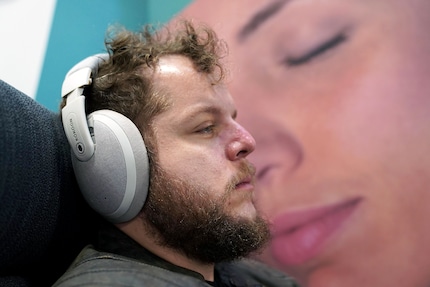Kokoon sleep ears: Night headphones with AI
Technology is becoming more and more pervasive. The Internet of Things is even supposed to support us while we sleep. Kokoon's headphones show that this definitely has potential.
At the CES in Las Vegas, all the trends in the world of technology come together. In a nutshell, it can be said that everything is becoming artificially intelligent. The aim of all the initiatives in the field of artificial intelligence (AI) is to improve the lives of its users. Shoes should become more comfortable, clothes should read out data and possibly even display it one day, luggage should follow its owners on its own and cars should drive themselves. It goes without saying that a good night's sleep should not be neglected. That's why sleeping aids are popping up everywhere at the trade fair, including in one of at least seven conference rooms in the Sands hotel complex.
Kokoon is like a pair of headphones, but it's not there to blast music at you on the tram so that you don't have to listen to the everyday life of this world, it's there to calm you down.
The self-experiment in the hustle and bustle of the trade fair
CES is loud. Just like Las Vegas. And the flat where video producer Stephanie Tresch and I set up our editorial team. Police sirens, the humming of the fridge or the heating, police helicopters, dishwashers, one of the three TV sets with endless amounts of reality TV or news about CES, the local weather and reports about crime in the neighbourhood... something is always making noise. It's been a long time since we've had some peace and quiet or a good night's sleep.
Therefore, testing the Kokoon headphones is not just a test of applicability and utility. We need some rest. Just a few minutes. Please. So we put on the headphones and take a seat on an armchair at the stand.

The golden cones inside the pinna are particularly striking. According to the blonde lady with neon pink coloured tips at the Kokoon stand, these are EEG sensors. They measure your brain waves, recognise how deeply and how well you sleep and adjust the sound in your ears.
The headphones rest gently on your ears and don't get particularly warm during the ten minutes or so of testing. You can press your head into the cushion without creating any pressure points. In theory at least, we would say that the Kokoons are bed-ready.
Sound is played into the shells via Bluetooth. Stephanie listens to meditative music. A man talks to me in my cocoon. In reassuring British English, he describes a breathing exercise he wants me to do. It's also interesting that the man says it's not about meditating or emptying my mind. It's just about becoming aware of my breathing. Breathe in through the nose, breathe out through the mouth. I go with it, thinking about the shoot that will take place after the test and how late tonight's night shift will be. Nose, mouth, nose, mouth. My shoulders relax. This is working. I'm slowly coming to rest.
But why EEG sensors?
We can't test the sensors that measure your brain waves in detail. This is because they need a certain amount of data to be effective and noticeable. They measure your sleep phases and the state of your wakefulness. Over time, the data will be used to make the music in your ears - usually soft sounds or things like the sound of the sea - louder or quieter, or even switch it off completely.
In addition, the Kokoons have active noise cancelling and play counter-sounds that counteract the noise outside the headphones. This works extremely well, as the headphones cancel out the noise at the trade fair, even if the Bluetooth connection to the phone is lost. The woman at the stand assures me that this is not a fault of the device, but happens because the hall is full of Bluetooth signals. CES has its own GPS system of sorts, which tracks your position via Bluetooth and shows you the route from stand to stand. This can lead to signal overlaps.
Do we sleep better with the cocoons? We can't say for sure. We would have liked to have tested it, but when Stephanie switches on the camera and the headlight, I realise that the few minutes of relaxation are over.
You can find all articles on CES 2019 here.
Journalist. Author. Hacker. A storyteller searching for boundaries, secrets and taboos – putting the world to paper. Not because I can but because I can’t not.
From the latest iPhone to the return of 80s fashion. The editorial team will help you make sense of it all.
Show all